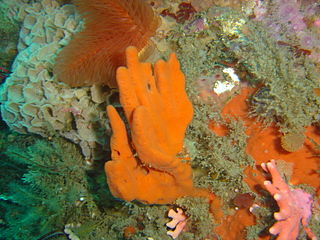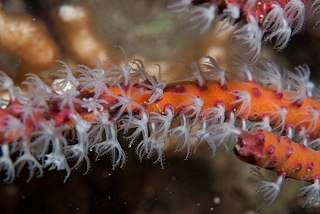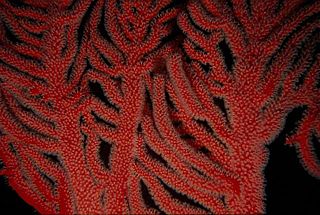The crumb-of-bread sponge is a species of sea sponge in the class Demospongiae.

The grey wall sponge is a species of sea sponge belonging to the family Ancorinidae. It is found around the coast of Southern Africa from the Northern Cape to KwaZulu-Natal. It is an endemic species.

The orange wall sponge is a species of sea sponge belonging to the order Trachycladida. It is found in the south Atlantic and Indo-Pacific oceans. Around the South African coast, it is known from the Cape Peninsula to Cape Agulhas.
Clathria dayi, the broad-bladed tree sponge, is a species of demosponge. It is known from the west coast of South Africa and around Cape Point to False Bay. It is probably endemic to this region.
The red encrusting sponge is a species of sea sponge. It is known only from the South African coast, on both sides of the Cape Peninsula. It is endemic to this region.
The brain sponge is a species of marine demosponge in the family Isodictyidae. This sponge is known from the west coast of South Africa to Port Elizabeth. It is endemic to this region.

The flat leaf sponge is a species of marine demosponge in the family Isodictyidae. This sponge is known from the west coast of South Africa to False Bay. It is endemic to this region.
The yellow encrusting sponge is a species of sea sponge in the family Biemnidae. This sponge is known from the west coast of South Africa to Port Elizabeth. It is endemic to this region.

Haliclona anonyma, the turret sponge or tubular fan sponge, is a species of demosponge. It is endemic to South Africa, where it occurs between the Cape Peninsula and Sodwana Bay.

Haliclona stilensis, the encrusting turret sponge, is a species of demosponge. It is known around the southern African coast, from Namibia to the South African south coast.
The black stink sponge, is a species of sea sponge in the family Irciniidae. This sponge is known around the Australian coast and around South Africa from the Cape Peninsula to Cape Agulhas.

The multicoloured sea fan is a species of gorgonian sea fan in the family Melithaeidae.

The gorgonian twig coral is a species of gorgonian sea fan in the family Anthothelidae.

The palmate sea fan is a species of gorgonian sea fan in the family Gorgoniidae.
Haliclona submonilifera, or the bubble bead sponge, is a deep-water demosponge from the continental shelf and slope off south-west Africa.
Clathria lissoclada, the triangular blade sponge, is a species of demosponge from the southern hemisphere.
Ectyonopsis pluridentata, the fused branch sponge, is a species of demosponge from South Africa.
Polymastia bouryesnaultae, the knobbly sponge, is a small and cryptic species of demosponge from South Africa and Namibia.
Penares sphaera, the crater sponge, is a deep sea demosponge from southern Africa.
Tetilla capillosa, the furry sponge, is a species of demosponge from southern Africa.








